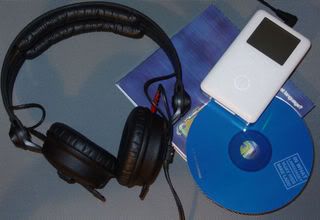DESIGN
The iPod Mini's purist Bauhaus-esque lines are a real joy to hold and look at. It's not very photogenic to be honest as it tends to appear a little Fisher-Price in the pictures (and probably one of the reasons that many non-iPod Mini owners tend to rag on it so much since they've never actually used one). But in the flesh, it is a very desirable thing. Even 9 months after I got my Mini, it was still refreshing sight every day. The click wheel and the display are inset into the extruded aluminium chassis of the Mini. The Mini's battery is built in and is not user replaceable.
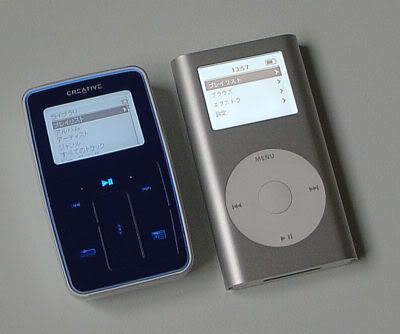
The Creative Zen Micro is a little less accomplished in terms of looks. If anything, it takes a cutesier line than the Mini, with a curved, pebble-like feel to the back of white plastic body (which is the same whatever colour of Zen you order). The front panel - which is one of several different colours depending on what you order - is dead flat though, which is a little jarring from a design point of view. Some of the fascia colours being a plastic overlay are a bit flat, including the Dark Blue. Half of the panel is taken up by the touch controls, while the other half is taken up by the display. Definitely a 'girlier' design than the iPod Mini, which in silver is about the most 'sexless' player you can get right now. The back of the Zen's body slides off to reveal the replaceable battery.
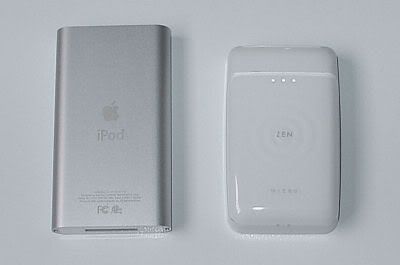
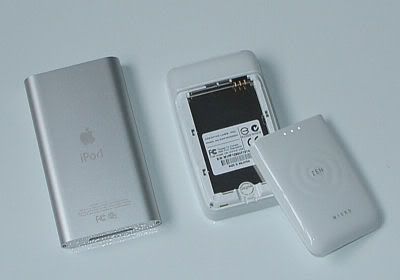
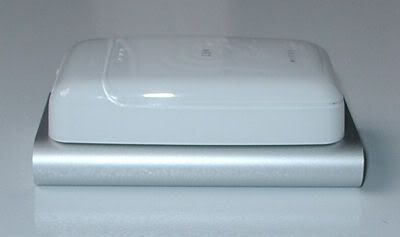
Both the iPod Mini and Zen Micro's displays are backlit of course, but the Mini's Click Wheel is not illuminated. the Zen's buttons are illuminated though, and when you're using it in a dark place, you can see the sides of the Zen light up too!

WHAT YOU GET
The iPod Mini ships with the obligatory iPod earphones, a belt clip, a power supply which has a firewire socket on it (so you use the included firewire cable with it), and firewire/USB connection cables.
The Zen Micro ships with silver/white earphones which are OK, a power supply which ends with a micro USB plug (which plugs directly into the Zen) and a USB connection cable, both a plastic bag for the Zen and a really odd looking 'bathtub' case, which can be fitted with a leg for it to act as a desktop stand for the Zen or fitted with the belt clip. The first lot of Zens (and both of the Zen's I had) shipped with two batteries.
FUNCTION
The Zen deals a body blow to the Mini here. Not content with 1Gb higher capacity and longer-life (which I never got... but there are plenty of people getting 'proper' battery time, so don't let my experiences put you off) replaceable batteries, the Zen Micro packs in an FM tuner, voice recorder and Outlook synchronisation. The Mini can of course be synced with contacts, etc but only with Macs (a program called Outpod can be used, but it's slightly cumbersome).
SOUND
The Zen is equipped with a headphone out that's similar in power to many Sony portables... 5-7mw per channel in terms of power. The iPod (non-European ones that is) is equipped with a relatively mighty 30mw per channel of power. The advantage of that is not just about volume. What the iPod does is to give you far more options in terms of what headphones you can use. There are zillions of headphones on the market and some are more efficient than others, that is they make better use of power. Whereas the Zen Micro would only work satisfactorily with very efficient phones, the iPod allow you to plug in some less efficient phones. Why is this an advantage? Many good phones aren't that efficient. On occasion the Zen Micro struggled to power even fairly efficient headphones, especially in passages with large bass.
The 'flat EQ' sound character and quality are not too different, and once again used with an efficient pair of phones, the basic sound quality is not really a deciding factor between these two. The iPod may have a lower SNR than the much-vaunted ninety-whatever decibel figure of the Zen, but both sound clean and clear.
There is a differentiation in the equalisation opportunities though: The Zen offers a custom equaliser as well as presets, and it can be tuned to deliver more controlled sound, as well as bigger bass than the iPod without distortion(as long as your phones are efficient enough)... which the iPod is prone to do with large amounts of low-frequency bass in the music. Codec support on the Zen is WMA, WAV and MP3. The Mini supports, MP3, WAV, AAC and Apple Lossless Compression.
The iPod Mini also offers a Line Out signal through the optional dock or through third-party accessories. This was very much missed on the Zen while plugging it into the car stereo for example, where the Zen sounded pathetic in comparison to the iPod.
Generally, for the rabid audiophile the iPod seems to be a better proposition: It supports lossless compression, and the Line Out allows amplification by high quality equipment, as well as having the more powerful headphone amp which allows for connection of less efficient phones which may offer more to the listener. The Zen with the working EQ however offers more for those who need to play with the sound. If you're going to walk around with a low-cost, efficient pair of phones all the time, or a pair of efficient canalphones such as the Etymotic ER-6i or Shure E3c, then the EQability of the Micro is very attractive.
MACHINE USABILITY
The iPod Mini is generally a pick it up and go device. It's very easy for most people to figure out and use. The Zen took a bit more figuring out, and not really because of the way the menus are laid out... because the navigation and menu layout is very similar in approach to the iPod (and all the better for it). The difference is the click wheel against the slide-touchpad, and the sensitivity of the slide-touchpad of the Zen takes some getting used to. It took me the first day of usage to get familiar with it. And even when I was experienced with using it, in situations such as bumpy train rides I was making wrong choices most of the time.
The flaw lies in the ease with which it is possible to brush against the 'buttons' on the touchpad, as well as the fact that you use the slide-pad in the centre not only to select, but also to "click". This leads to you needing to exercise precise control over how much pressure to apply when you're sliding your fingers across the pad.
Really, apart from the physical manifestation of the control interface there is not much to choose from the two in terms of the way you use the player. Both are pretty well paid out. And the controls are inferior on the Zen although it is by no means unusable. It's just that it can be frequently irritating.
SOFTWARE USABILITY
iTunes is pretty much the benchmark of music management and synchronisation at the moment. Creative's Mediasource on the other hand has less user-interface niceties but it does have some unique additions of it's own.
The thing I find best about iTunes is that it is arguably the sync and management software which 'gets in your way' the least. It's easy to get into, and that may lead some into believing it is simplistic. It is simplistic in use, but it has a lot of music organisation and playlisting features not found in anything else. The features which most people need are presented in a very transparent manner. The iPods by the way do something that's not yet done by any other player: They report back to iTunes what you played and when. This allows you to do things like "create playlists of Jazz music which I haven't listened to for six months". Quite a powerful feature, once you start using it in earnest. The display is uncluttered and quite self-explanatory.
Creative's Mediasource probably won't trip off most people's tongues if you ask for a list of the leading jukebox software for the PC. It's certainly not the leader of the pack, but is at least respectable and packs considerably more power than such compromised offerings such as Sonicstage from Sony. There is a decidedly more technological nature to using Mediasource. By that I mean that you need to be just a bit of a techno-head to be able to use and configure it beyond the basics. Befitting it's more tech nature, Mediasource does pack more features than iTunes. One such useful feature is the real-time MP3 encoding facility, which means you can "rip" cassette tape, LP's etc to MP3 directly. Because Mediasource is designed to work with almost every Creative player, it has some nice things built in to it, such as automatic transcoding-on-demand for high bitrate files in order to fit on lower capacity devices. The music library display is configured in such a way that on smaller screens, everything appears very cluttered. The way windows are set to display does need more work for it not to be a minor annoyance when you connect your player as the track display windows pop up in non-optimal ways.
Onto DRM and related issues. Both of course support DRM and allow encrypted files to be loaded, but the usage is a little different. With the latest firmware of the Zen Micro, it is possible for it to be used directly with Windows Media Player 10... which brings in another set of possibilities. I'm not going into great deal of detail with that except to say that if you perfer M$'s approach to music syncing, you can take advantage of it, so for now let's stick to iTunes / Mediasource. iTunes does not allow you to transfer music back to the PC that you didn't have on it in the first place. This is an easily circumventable thing with third party software since the files are just renamed and not encrypted, but it is not possible from within iTunes... so it's basically a casual piracy prevention measure, which I think that it's a better approach than Sony's Sonicstage for example, where even your own rips are locked down tight with DRM encryption. MediaSource goes one step better though: it allows for the free movement of unsecured music files to and from the player on any PC.
Both applications allow you to simply drag & drop music folders / files from the Explorer onto the respective windows to load the tracks. Wait... you thought this was a de facto feature? The people at Sony don't seem to think so ;) Neither iTunes nor Mediasource works very well with multiple screen systems. iTunes works pretty well with a 1280 x 1024 monitor, but Mediasource could actually do with a slightly larger display for optimum usage mainly due to the aforesaid cluttered display.
iTunes' not inconsiderable power is hidden in an otherwise simplistic user interface, which really comes to life once you start working with the iPod. Mediasource is less pleasant to pick up, but it is not unusable by any means and it has some good additional facilities not seen in iTunes as well as allowing two-way transfer of unsecured files.
BATTERY / POWER
The battery is one area which I can't comment on with the Zen Micro. With both Micros that I returned, regardless of the charging regime I was getting battery life shorter than or equivalent to the iPod Mini. The Mini in my possession went for anywhere between 4 and 6 hours depending on my pattern of use. That's short of the 8 hours but I am an inveterate player fiddler; I'm constantly switching my music and I do have the backlight set to come on whenever I touch the player, so it is not unreasonable given the iPod Mini's claimed battery life. I found that while in Commuter Mode, the Mini held up to use without problems. 1-2 hours commute, arrive at work, plug Mini into any available PC to charge, listen if need be during day, go home for another 1-2 hour trip with plenty of juice left.
Both players charge from USB sockets as well as the included power supplies. With both players, the first few times you use it it's a good idea to fully charge the battery using the supplied PSU's just to condition the batteries. One nice touch about the Zen is that the side lights pulse in a heartbeat-like way when it's charging.
DATA STORAGE
The iPod Mini appears as a drag & drop USB Mass Storage device for data. The Zen is a little more complicated. It is possible to switch it into USB Mass Storage (UMS) mode, but this involves dedicating areas of the disc to UMS mode. That is if you define a 1Gb partition for UMS mode, then you lose 1Gb from the 5Gb as far as music storage is concerned. The Zen also has a limitation of 2Gb for this UMS mode. When you plug in the Zen to a PC which hasn't got all the Zen software installed, you have to switch it into UMS mode via a setting several layers down in the menu. system. It's all a bit bizarre, although it works. I dedicated a 1Gb partition for data, and it didn't really cause me any practical problems.
ZEN-ONLY FUNCTIONS
Replaceable battery: The battery cover slides off to reveal the battery, which is easy to remove and replace. With a number of batteries (which are tiny and thin, very portable) you'd have enormous potential run-time.
FM Tuner: I experienced decent reception of my favourite stations, and the recording also worked without a hitch.
Voice recorder: The recording quality is acceptable for spoken voice, although voice pickup isn't great... in a very quiet room, I had trouble picking out words said at normal volume about 2.5 meters distance from the Mic. This ability also differed quite a lot according to whether the mic (on the top of the unit) was pointing to or away from the speaker.
Outlook Synchronisation: Simple, and it works.
WHY DID I GET THE ZEN OVER THE IPOD?
I mentioned that I got rid of the iPod before I returned the second Zen. And it was the case that I chose to use the Zen over the iPod Mini. Why? Because I wanted flexibility while doing a lot of travelling: The ability to carry multiple batteries was important to me, as well as being able to record voice notes on the player.
However, if a compact external battery pack was available for the Mini for those travelling occasions, and if an iTalk was available for the Mini, I'd have gone back to the iPod. Ultimately it's about the music and for me, the whole iPod/iTunes package rules in terms of being able to manage, choose and load music onto my player in the most effortless and flexible way possible. As I said before, if you're a commuter kind of person who listens to music on the way to work and back, and works with a computer during the day (which you can plug the Mini into) then the iPod Mini is unlikely to be a problem in terms of battery life.
The Zen is packed with features and it's a very likeable player. The choice you make should depend on the extra battery facility and the additional features of the Zen, and whether you'd actually need/use those additional features. If you don't need them, the iPod Mini has the edge as a player that features outstanding hardware/software integration and the iPod interface... which is still the one to beat, allowing you the most immediate access to your music library. I also think the iPod Mini looks way better :D
